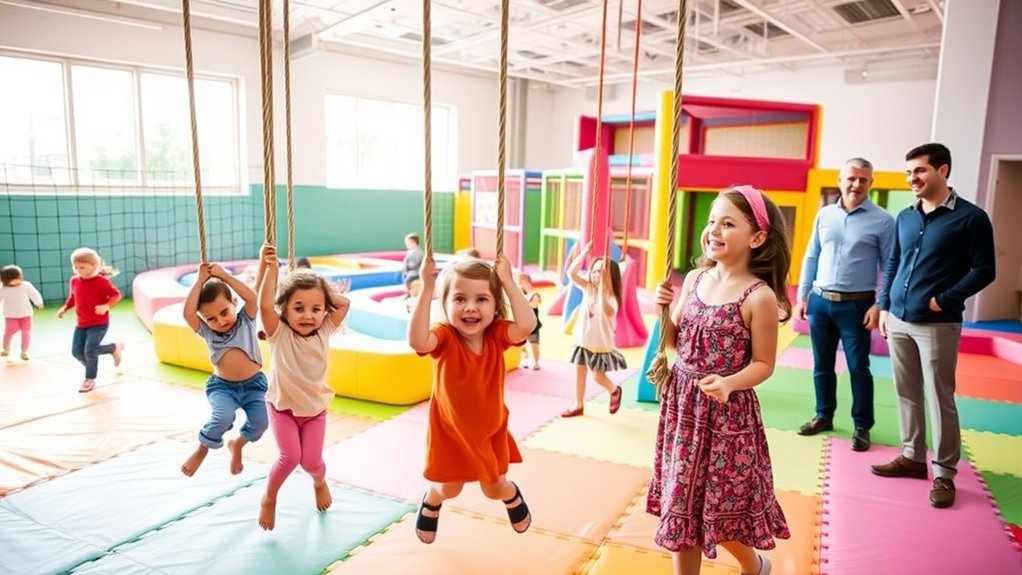Play gyms are the holy grail of baby development, right? As a parent, you probably have plenty of questions about how to use them effectively. From the best age to start to safety concerns, it’s vital to understand the ins and outs of these essential tools. Let’s explore what features to look for, how to guarantee safety, and the best practices for cleaning and maintenance. Your baby’s playtime can be both fun and enriching.
What Features Should I Look for in a Play Gym?
When choosing a play gym, what features really matter?
You’ll want to look for a gym that offers a variety of textures and colors to stimulate your baby’s senses. Consider one with adjustable arches, allowing you to customize the setup as your little one grows.
Look for toys that dangle at different heights, encouraging reaching and grasping, which helps develop motor skills. A soft, cushioned mat provides a safe space for tummy time and play.
Additionally, check for easy cleaning options, as spills are inevitable. Finally, lightweight and portable designs can be a game-changer, making it simple to move the gym around your home or take it on the go.
Prioritizing these features can enhance your baby’s playtime experience.
Are Play Gyms Safe for My Baby?
How can you guarantee your baby’s safety while using a play gym? First, choose a gym that meets safety standards and has no small parts that could pose a choking hazard.
Always supervise your baby during playtime to make certain they’re engaging safely with the toys and structures. Check the surface beneath the gym; a soft mat can cushion falls.
Inspect the play gym regularly for wear and tear, and clean it frequently to minimize germs. Make sure your baby is the right age and size for the gym, as each model has specific guidelines.
Trust your instincts—if something doesn’t feel right, it’s best to put the gym away until you can confirm it’s completely safe. Your baby’s safety is a priority.
How Do Play Gyms Promote Development?
While ensuring your baby’s safety is essential, it’s equally important to understand how play gyms can foster their development. These engaging spaces encourage sensory exploration, motor skills, and cognitive growth.
| Developmental Aspect | How Play Gyms Help |
|---|---|
| Sensory Skills | Colorful toys and textures stimulate vision and touch. |
| Motor Skills | Reaching and grasping encourage coordination and strength. |
| Social Skills | Playtime can promote bonding and communication with caregivers. |
| Cognitive Skills | Interactive elements promote problem-solving and curiosity. |
| Emotional Development | Safe environments help babies explore emotions and self-regulation. |
When Should I Introduce a Play Gym to My Child?
At what age can you start introducing a play gym to your child? Most experts recommend beginning around 2 to 3 months, when your baby is more alert and ready for interactive play.
Here are some signs that indicate it’s the right time:
- Your baby can hold their head up while lying on their tummy.
- They show interest in reaching for toys or objects.
- They respond to sounds and visual stimuli around them.
- They seem bored with their current play environment.
Introducing a play gym during this stage can enhance their motor skills and cognitive development.
Just remember to supervise your little one and guarantee the environment is safe for exploration.
How Do I Clean and Maintain a Play Gym?
Keeping your play gym clean and well-maintained is essential for your baby’s health and safety. Start by regularly wiping down surfaces with a mild, non-toxic cleaner and a soft cloth.
Make sure to check manufacturer guidelines for fabric parts; many can be machine-washed or spot-cleaned. Pay attention to toys and attachments, as they can harbor germs—disinfect them periodically.
Inspect the gym for wear and tear, ensuring all components are secure and safe for use. Also, consider storing the gym in a dry, clean environment to prevent mold and mildew.
Frequently Asked Questions
Can Play Gyms Be Used for Babies With Special Needs?
Yes, play gyms can be beneficial for babies with special needs. They promote sensory exploration and motor skills. You should consult with a healthcare professional to ascertain the equipment suits your baby’s unique needs and abilities.
What Age Range Is Best for Using a Play Gym?
From birth to around six months, you’ll find play gyms are perfect for your little one’s development. They encourage exploration and sensory discovery, helping your baby thrive during those essential early months of life.
Are There Eco-Friendly Play Gym Options Available?
Yes, there are eco-friendly play gym options available. Many brands use sustainable materials, organic fabrics, and non-toxic finishes, ensuring a safer environment for your child while being mindful of the planet’s health.
Can Siblings Use the Play Gym Together?
Yes, siblings can definitely use the play gym together! It’s a great way for them to bond, share experiences, and engage in imaginative play. Just make certain there’s enough space and safety for everyone involved.
How Do I Store a Play Gym When Not in Use?
You can store a play gym by folding it neatly and placing it in a closet or under a bed. Make certain it’s clean and dry to keep it in good condition for future use.
Conclusion
Incorporating a play gym into your baby’s routine can be a joyful experience, fostering their growth while creating cherished memories. As you watch your little one giggle and reach for colorful toys, you’ll realize that these simple moments are essential for their development. Just like you, they’re learning and exploring the world around them. By ensuring safety and proper maintenance, you’ll not only support their journey but also create a nurturing environment filled with love and laughter.
